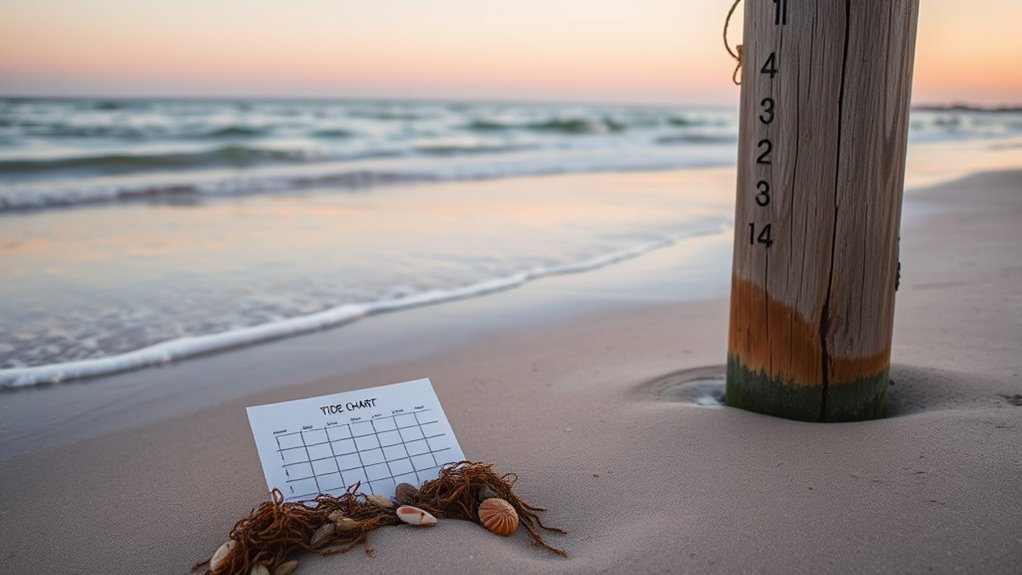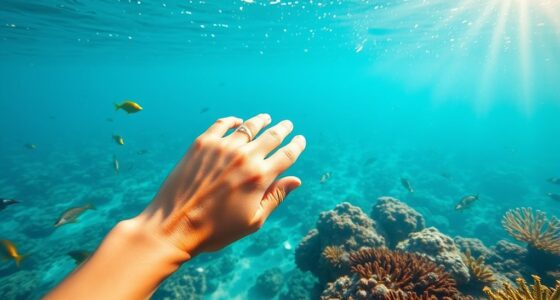Before your morning swim, check local tide charts for high (“H”) and low (“L”) tide symbols and note the times when water levels peak or dip. Pay attention to the moon phase, as it influences the strength of tides, and consider the local geography, which can affect tide behavior. Recognize the typical cycle of around 12 hours and plan around slack tides for safer, calmer conditions. Keep reading to learn how to interpret these signals for a smooth, safe swim.
Key Takeaways
- Check local tide charts for high (“H”) and low (“L”) tide times specific to your location.
- Note tide level symbols and heights to understand current water conditions.
- Identify slack tide periods when currents are minimal for safer swimming.
- Observe the timing of tides relative to lunar and solar cycles for better prediction.
- Incorporate weather and geographic features into your planning for safety and optimal conditions.
Understanding What Ocean Tides Are
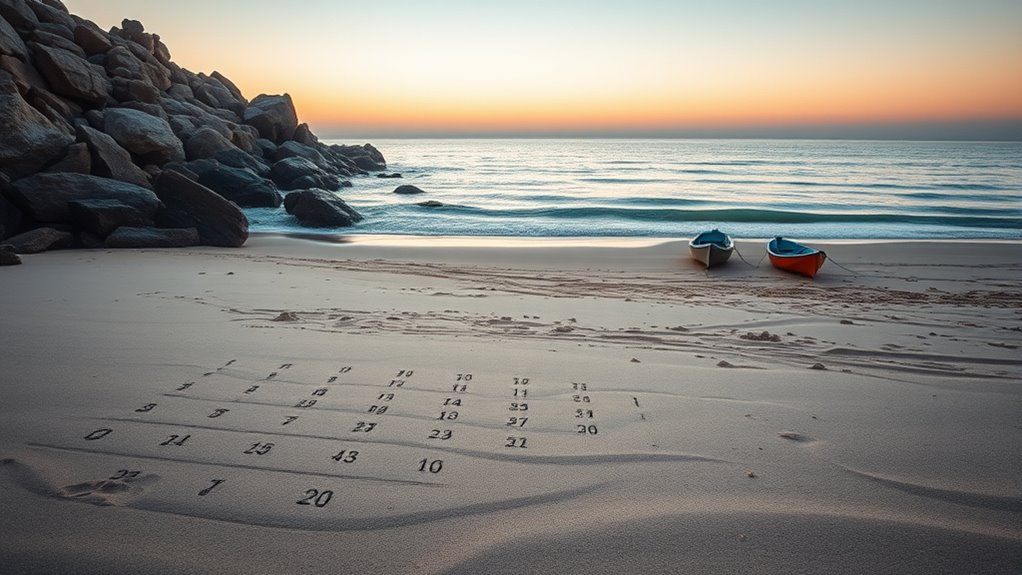
Ocean tides are the regular rise and fall of sea levels caused mainly by the gravitational pull of the moon and the sun. When the moon’s gravity pulls on the Earth’s water, it creates a bulge known as a high tide in the area facing the moon. Simultaneously, on the opposite side of the Earth, another high tide occurs due to centrifugal force. Between these bulges, water levels drop, creating low tides. These shifts happen roughly twice a day, though the timing and height can vary based on your location. Understanding these basic movements helps you anticipate when the ocean will be most accessible or safe for activities like swimming or surfing. Recognizing the natural rhythm of tides is essential for planning your beach outings effectively.
The Difference Between High Tide and Low Tide
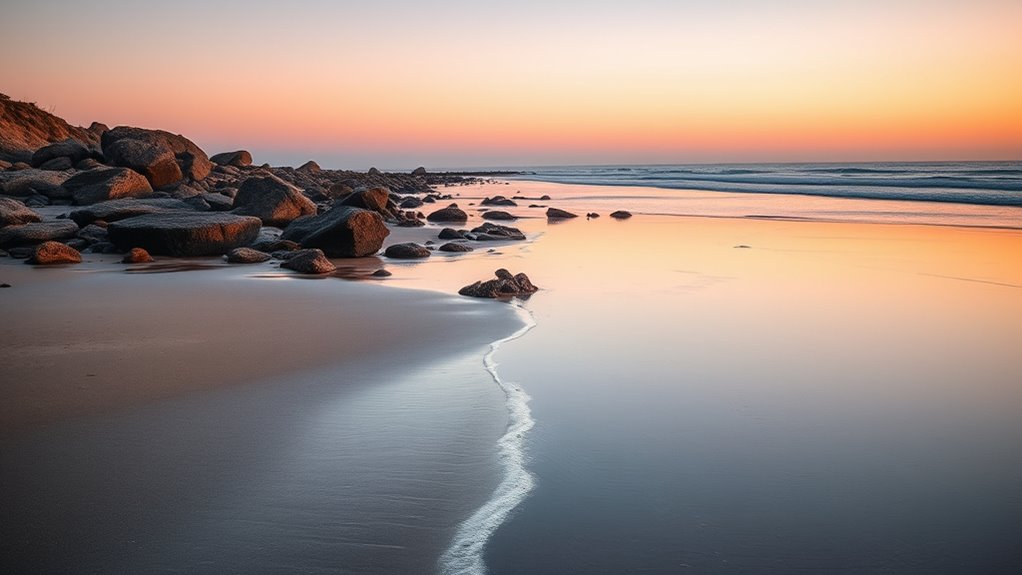
Understanding the difference between high and low tide helps you anticipate changes in water levels and tidal heights. You’ll notice the timing of these tides affects when the water reaches its highest or lowest points. This knowledge is essential for swimmers planning safe times to enter or exit the water. Additionally, awareness of tide patterns can help you use technology, like intelligent tutoring systems, to better understand local tide schedules and ensure safe swimming times. Recognizing tide cycles can further improve your ability to predict these changes accurately. Being familiar with lifestyle habits, such as planning outdoor activities around tide conditions, can also enhance your overall experience. Moreover, understanding tidal dynamics can help you interpret natural indicators and improve your overall awareness of coastal environments. Gaining insight into tidal influences can deepen your understanding of how gravitational forces from the moon and sun drive these predictable patterns, enriching your appreciation of coastal ecosystems.
Tidal Height Variations
Have you ever wondered why the water level rises and falls so dramatically along the coast? Tidal height variations are the difference between high tide, when the water reaches its highest point, and low tide, when it drops to its lowest. These fluctuations happen because of the moon’s gravitational pull, which pulls water toward it, creating bulges in the ocean. As Earth rotates, these bulges move around the globe, causing the water level to change. The magnitude of these changes varies by location, influenced by factors like coastline shape and underwater features. Understanding tidal height variations helps you anticipate how much water will rise or fall, which is essential for planning your swim, avoiding hazards, and enjoying safe, prime beach conditions. Additionally, the effectiveness of tidal predictions depends on accurate measurements and understanding local geography. Accurate tidal predictions also require knowledge of the local geographic features that can influence tide behavior in specific areas.
Timing of Tides
Ever wondered why high tide and low tide occur at different times each day? It’s because tides follow a roughly 12-hour cycle influenced by the moon’s position and the Earth’s rotation. As the moon orbits, its gravitational pull causes water to bulge out on the side closest to it, creating high tide. Meanwhile, a second, smaller bulge occurs on the opposite side. Between these bulges, low tide happens. Since the Earth rotates approximately once every 24 hours and 50 minutes, high and low tides shift each day. This means the timing of tides isn’t fixed; it changes daily. To plan your swim, check local tide charts, which tell you when high and low tides will occur based on this regular, yet shifting, cycle. Additionally, understanding signs of spoilage in ocean water can help ensure safe swimming conditions. Being aware of tidal patterns can also help you anticipate the best times for your ocean activities and avoid dangerous currents. Recognizing tidal ranges is crucial for safe and enjoyable ocean swimming, especially since tidal range can vary significantly depending on location and lunar phase. Moreover, factors like shoreline topography can influence local tide behavior, making it important to consider local geographic features when planning your swim.
Tidal Influence on Swimmers
High tide and low tide profoundly affect your experience in the water. During high tide, the water level rises, making the shoreline more accessible and often safer for swimming. You’ll notice the currents are stronger, which can either help you swim faster or make conditions more challenging. Understanding tide patterns can further enhance your safety and enjoyment in ocean swimming. Recognizing tidal influence can help you anticipate changes in water conditions and plan your swim accordingly. Low tide reveals more of the beach and exposes rocks and sandbars, creating hazards or new swimming spots. The water might be shallower, slowing your pace, or creating ripples and eddies that can pull you off course. Incorporating natural elements like rocks or driftwood can help you identify safe areas and enjoy a more scenic experience. Additionally, being aware of precious metals investment trends can inform your decision-making if you’re considering diversifying your investments. Being familiar with oceanography can provide insights into how tides operate and influence marine environments, further informing your planning. Adjust your timing and expectations accordingly for a safer, more enjoyable swim. High tide can bring clearer water and better wave action, while low tide might mean calmer, more predictable conditions.
How Tides Are Caused by the Moon and Sun
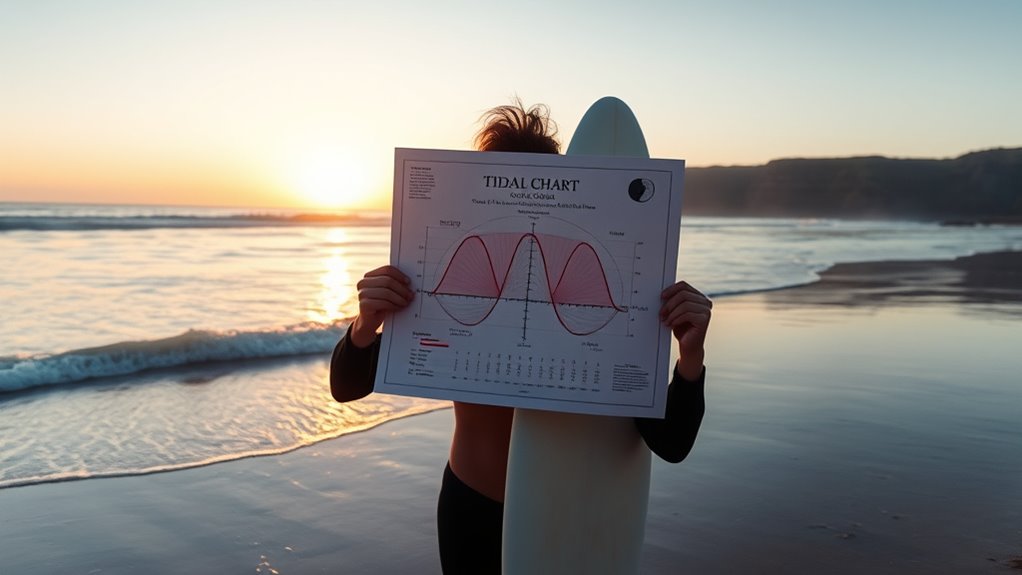
You might be surprised to learn that the moon’s gravity pulls on Earth’s waters, creating high tides, while the sun’s gravity also plays a role. These gravitational forces follow predictable lunar and solar cycles that cause the regular rise and fall of tides. Understanding these effects helps you anticipate how tides change throughout the day and month.
Gravitational Pull Effect
How do the moon and sun influence ocean tides? Their gravitational pull creates the primary force behind tides. When the moon’s gravity pulls on Earth’s water, it causes a bulge on the side closest to the moon. Simultaneously, a second bulge forms on the opposite side due to inertia. The sun’s gravity also affects tides, but less strongly. Here’s how it works:
- The moon’s gravity pulls water toward it, creating a high tide.
- A second high tide occurs on the opposite side of Earth.
- When the sun aligns with the moon, their combined pull causes especially high tides, called spring tides.
- When the sun and moon are at right angles, their pulls partially cancel, resulting in lower, neap tides.
- The gravitational interaction between the moon, sun, and Earth is the fundamental reason for the cyclical rise and fall of ocean waters you observe. Additionally, understanding tidal cycles can help you plan your morning swim more effectively. Recognizing the tidal range can also enable you to anticipate the water levels and ensure a safer, more enjoyable swim. Being aware of tidal predictions can further improve your planning for outdoor activities near the water. Exploring tidal patterns over time can deepen your understanding of local water behaviors and improve your safety.
Lunar and Solar Cycles
Have you ever wondered why tides change predictably over days and weeks? The answer lies in the lunar and solar cycles. The moon’s gravity pulls on Earth’s waters, creating high and low tides. As the moon orbits, its gravitational pull varies, causing regular tide patterns. The sun also influences tides, though to a lesser extent. When the sun, moon, and Earth align during new and full moons, we experience higher high tides called spring tides. Conversely, during quarter moons, when the sun and moon are at right angles, we get lower high tides known as neap tides. These cycles follow approximately 29.5 days for the lunar cycle and 365 days for the solar cycle, shaping the predictable ebb and flow of ocean tides you observe.
Recognizing Tidal Cycles and Patterns
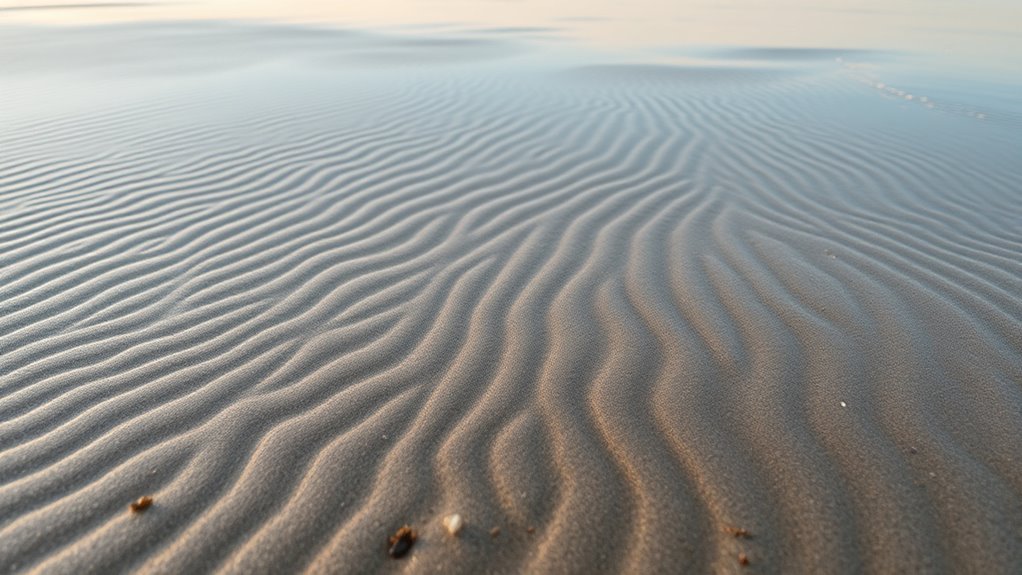
Recognizing tidal cycles and patterns involves paying close attention to how water levels rise and fall over time. By observing these changes, you can identify consistent rhythms that reveal the tide’s behavior. To do this effectively, try:
Pay attention to water level changes over time to recognize tidal patterns and improve your ocean experience.
- Monitoring water levels at the same location daily to notice patterns.
- Noting the time gaps between high and low tides.
- Watching for the duration of each tide phase.
- Identifying any irregularities or anomalies caused by weather or moon phases.
- Understanding the influence of local geography on tidal patterns, which can vary from one coastline to another.
- Being aware of production quantity variance that might affect the accuracy of tidal predictions based on historical data.
- Recognizing the impact of UV radiation on your skin, which is crucial for sun safety during outdoor activities.
Over time, you’ll recognize recurring cycles—such as semi-diurnal tides that have two high and two low tides daily. Spotting these patterns helps you predict the best times for your swim, ensuring safer and more enjoyable ocean experiences.
Using Tide Charts to Plan Your Swim
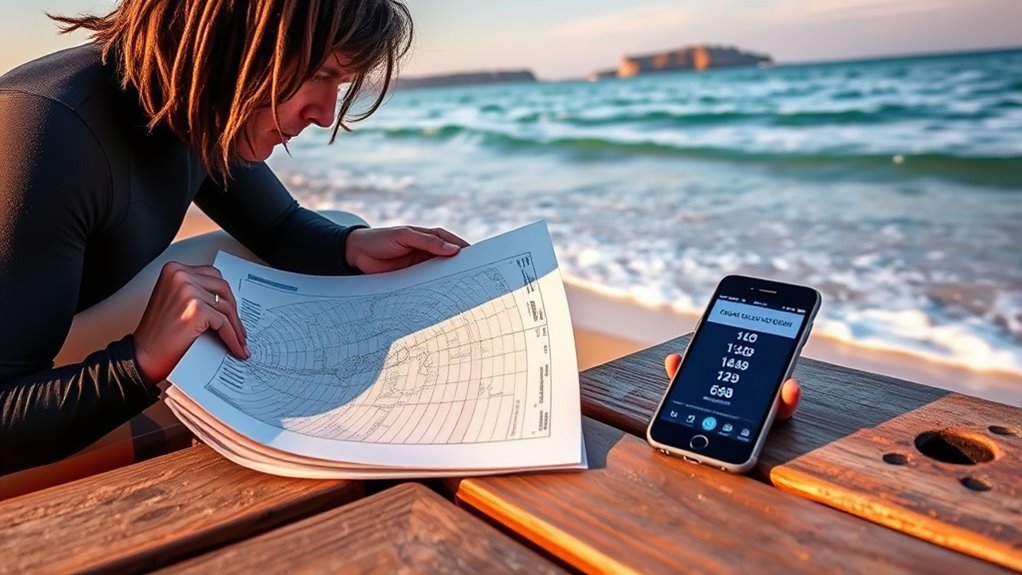
To plan your swim effectively, you need to understand how to read tide charts. Recognizing symbols and identifying high and low tides helps you choose the safest and most enjoyable times. With this knowledge, you can schedule your swim around the best tide conditions. Additionally, detecting passive voice can improve your overall writing clarity and effectiveness.
Interpreting Tide Chart Symbols
Ever wonder how to quickly interpret the symbols on a tide chart to plan your swim? It’s easier than you think. First, look for the tide level symbols: a solid line indicates high tide, while a dashed line shows low tide. Second, check the times marked alongside these symbols to know exactly when each tide occurs. Third, identify any moon phase icons, which can hint at stronger tides. Fourth, note any weather icons, like wind or storm symbols, that might influence water conditions. Recognizing these symbols helps you understand tide movements at a glance. With practice, you’ll quickly grasp what each symbol means, making your pre-swim planning more accurate and less stressful. Mastering these symbols ensures you hit the water at the perfect tide.
Identifying High and Low Tides
Once you’ve learned to interpret the symbols on a tide chart, the next step is to identify when high and low tides occur. Look for the labeled “H” for high tide and “L” for low tide on the chart. The vertical position of the tide line shows the tide’s height relative to average sea level. High tides are when the line peaks, indicating the highest water level, while low tides are when it dips, showing the lowest. Check the corresponding times listed next to these points to plan your swim accordingly. Keep in mind that tides change predictably, so noting these peaks and dips helps you choose the best time for safety and ideal water conditions. Familiarizing yourself with this pattern makes your mornings in the water much smoother.
Planning Swim Times Effectively
Wondering when to plan your swim for the best water conditions? Using tide charts makes it simple. First, check the times of upcoming high and low tides. Second, aim to swim during the slack tide—shortly after high or low tide—when water is calmer. Third, avoid times when the tide is rapidly changing, as currents can be strong. Fourth, plan your swim around the flood tide (incoming) or ebb tide (outgoing), depending on your preference for water movement. By following these steps, you guarantee safer, more enjoyable swimming. Always double-check tide times before heading out, especially if you’re in unfamiliar waters. Proper timing helps you maximize your time in the water and avoid tricky currents.
Reading a Tide Table Step-by-Step
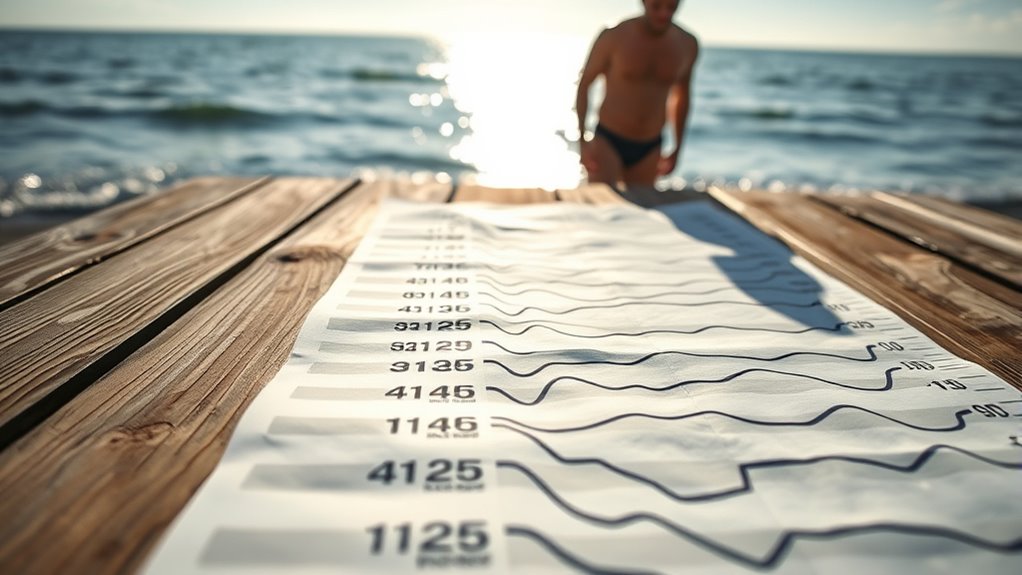
To effectively read a tide table, you need to understand its layout and the information it provides. First, locate the date you’re interested in, usually listed along the top or side. Next, find the specific day’s row or column, which shows the tide times for that day. Look for the columns labeled “High Tide” and “Low Tide.” The times listed indicate when the tide reaches its highest or lowest point. Pay attention to the tide heights too, which are usually given in feet or meters. Some tables include additional info like moon phases or tide types. By following these steps, you’ll quickly identify the best times for your swim, ensuring you catch the tide at its ideal point.
Interpreting Graphs and Tide Predictions
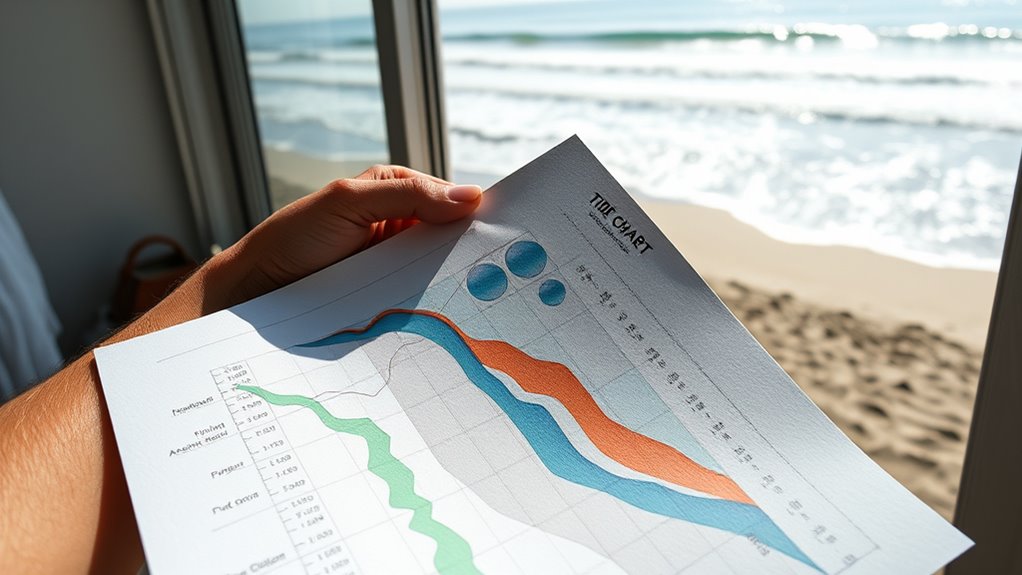
Interpreting graphs and tide predictions allows you to visualize how tides change over time, making it easier to plan your activities. These tools provide a clear view of high and low tides, helping you decide the best time for your swim. To make the most of these predictions, focus on:
- Noticing the tide cycle pattern—when high and low tides occur.
- Reading the y-axis to see tide heights at different times.
- Tracking the time labels to determine when tides rise or fall.
- Comparing multiple days to understand tidal variations.
Factors That Can Affect Tidal Timing

Several factors can influence the timing of ocean tides, making them less predictable than simple patterns suggest. Lunar phases, especially new and full moons, cause higher high tides and lower low tides, known as spring tides. Conversely, quarter moons bring neap tides with less extreme differences. The shape of the coastline and seafloor features also impact local tide timing, causing variations even within short distances. Weather conditions, such as strong winds and atmospheric pressure changes, can temporarily alter sea levels, affecting tide heights and timing. Additionally, geographic location plays a role; bays and estuaries often experience delayed or amplified tides compared to open coastlines. By understanding these factors, you can better anticipate when the tides will be favorable for your swim.
Tips for Choosing the Best Time for Your Swim
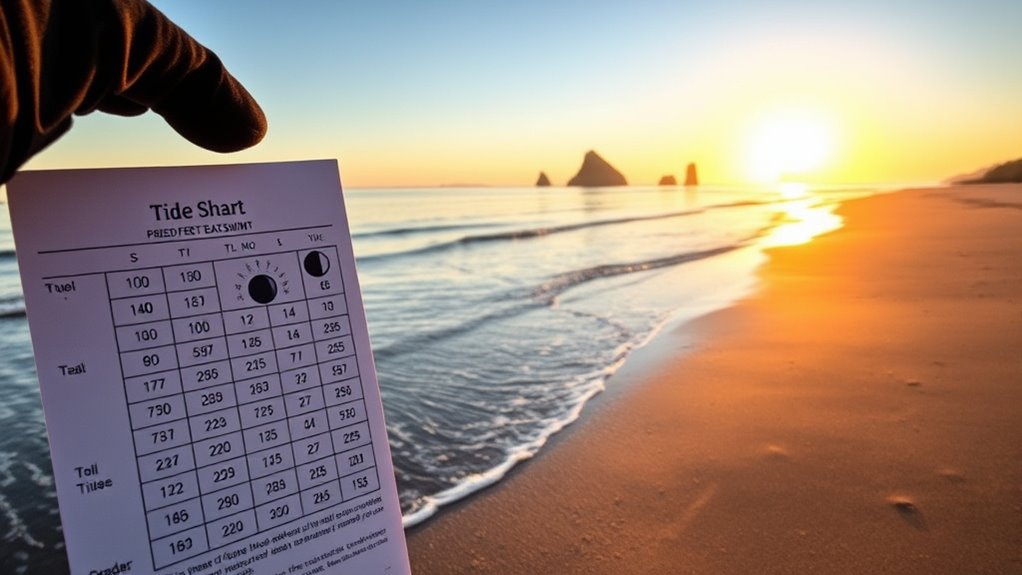
Choosing the best time for your swim means paying attention to tide schedules and local conditions. To optimize your experience, consider these tips:
- Check tide charts daily to identify high and low tides, aiming for mid-tide periods when water levels are stable.
- Plan around slack tide, when currents are minimal, making swimming safer and easier.
- Avoid strong tidal flows by steering clear of peak current times, typically during the progression between high and low tide.
- Observe local patterns, as weather and seasonal changes can influence tidal behavior, helping you select calmer, more predictable times.
Staying Safe During Different Tidal Conditions
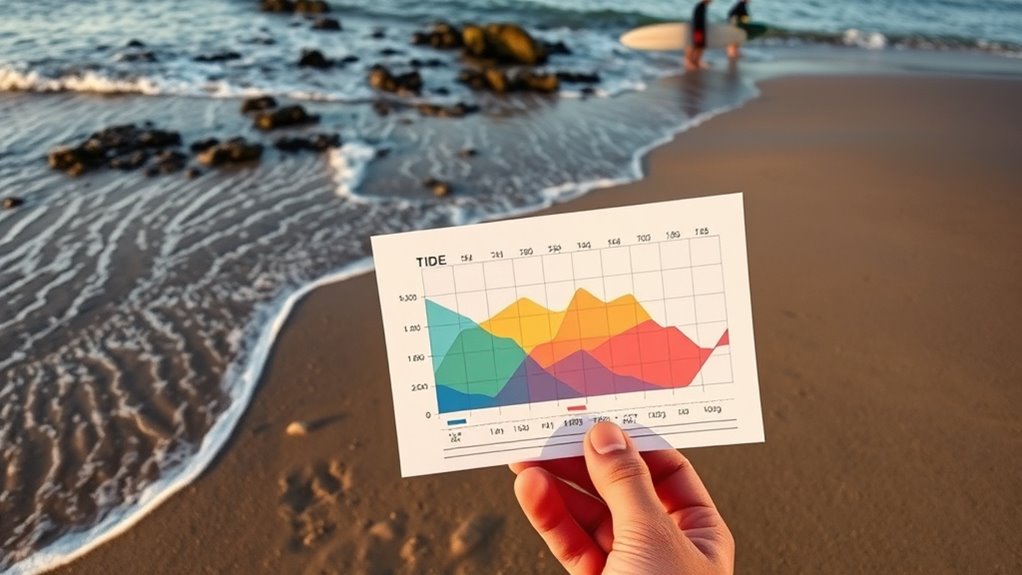
Understanding how tidal conditions change can considerably enhance your safety while swimming or exploring the shoreline. During high tides, water levels rise quickly, making areas more dangerous if you’re not cautious. Low tides expose rocks and sharp objects, increasing injury risk. Always check tide charts before heading out, and know the difference between tidal phases.
| Tidal Condition | Safety Tip |
|---|---|
| High Tides | Avoid swimming near rocks or steep shorelines. |
| Low Tides | Watch for sharp rocks and sudden drop-offs. |
| Incoming Tides | Stay alert; water can rise faster than expected. |
| Outgoing Tides | Be aware of rip currents forming as water recedes. |
Adjust your plans accordingly, stay vigilant, and never underestimate tidal changes.
Frequently Asked Questions
How Accurate Are Tide Predictions for Specific Locations?
Tide predictions can be quite accurate for specific locations, especially when based on detailed historical data and advanced models. However, factors like weather changes, atmospheric pressure, and wind patterns can cause deviations. You should use tide charts as a reliable guide, but always check for real-time updates or local alerts. This way, you’ll better plan your swim and avoid surprises caused by unexpected tide shifts.
Can Weather Changes Affect Tidal Timings?
Weather changes can definitely affect tidal timings. Storms, high winds, and atmospheric pressure shifts influence sea levels and water movement. When a storm approaches, it can cause higher or lower tides than predicted, and wind-driven waves may alter the timing slightly. You should check local weather forecasts before your swim, as these conditions can make tides less predictable and affect your safety and enjoyment.
Are There Apps That Automatically Update Tide Information?
Imagine a trusted lighthouse guiding your morning swim—there are indeed apps that automatically update tide info, acting as your digital compass. These apps sync with real-time data, so you’re never left in the dark about changing tides. Popular options like Tides Near Me or My Tide Times send alerts and forecasts straight to your device, ensuring you ride the waves confidently, no matter how weather shifts or the ocean dances to its own rhythm.
How Can I Identify Local Tide Patterns Visually?
To identify local tide patterns visually, start by observing how the water level changes at your spot over a few days. Look for consistent rising and falling patterns, noting the times when tides are highest and lowest. Use markings or notes to track these fluctuations. Over time, you’ll recognize the rhythm, helping you predict when it’s safest and best for your swim, especially during high or low tide.
What Equipment Is Best for Measuring Tides at the Beach?
Imagine you’re a tide detective, and your best tools are simple yet precise. A tide gauge or a portable tide monitor captures the ocean’s secret whispers, showing you how high or low the water will dance. You might also use a weather-resistant smartphone with tide apps or digital sensors. These devices become your trusted allies, helping you read the ocean’s mood before you plunge into the waves.
Conclusion
Mastering tide reading is like tuning into nature’s rhythm—once you understand its patterns, you can effortlessly catch the perfect wave. I remember planning my morning swim, checking the tide chart, and arriving just as the water reached its peak. With a little practice, you’ll find yourself in sync with the ocean’s pulse, turning every swim into a smooth, safe, and enjoyable experience. Embrace the tide, and let the ocean guide you.

